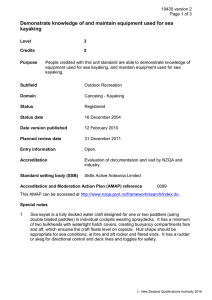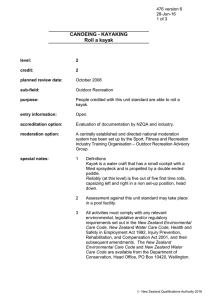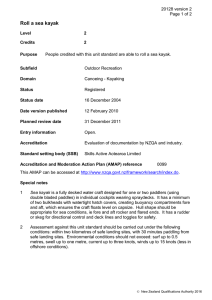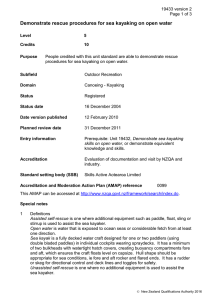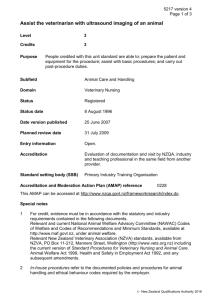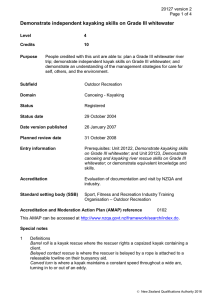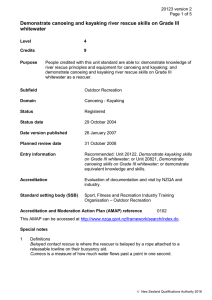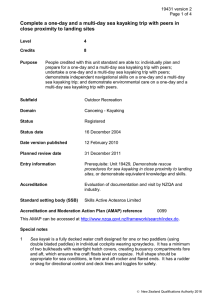Demonstrate rescue procedures for sea kayaking in close proximity to
advertisement
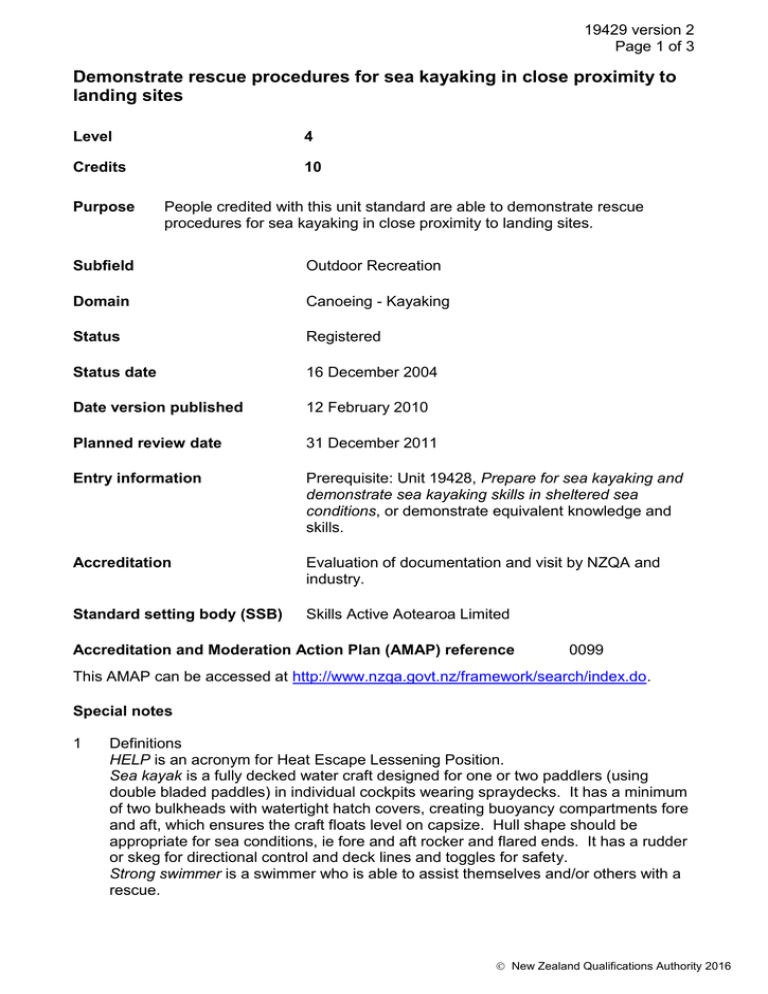
19429 version 2 Page 1 of 3 Demonstrate rescue procedures for sea kayaking in close proximity to landing sites Level 4 Credits 10 Purpose People credited with this unit standard are able to demonstrate rescue procedures for sea kayaking in close proximity to landing sites. Subfield Outdoor Recreation Domain Canoeing - Kayaking Status Registered Status date 16 December 2004 Date version published 12 February 2010 Planned review date 31 December 2011 Entry information Prerequisite: Unit 19428, Prepare for sea kayaking and demonstrate sea kayaking skills in sheltered sea conditions, or demonstrate equivalent knowledge and skills. Accreditation Evaluation of documentation and visit by NZQA and industry. Standard setting body (SSB) Skills Active Aotearoa Limited Accreditation and Moderation Action Plan (AMAP) reference 0099 This AMAP can be accessed at http://www.nzqa.govt.nz/framework/search/index.do. Special notes 1 Definitions HELP is an acronym for Heat Escape Lessening Position. Sea kayak is a fully decked water craft designed for one or two paddlers (using double bladed paddles) in individual cockpits wearing spraydecks. It has a minimum of two bulkheads with watertight hatch covers, creating buoyancy compartments fore and aft, which ensures the craft floats level on capsize. Hull shape should be appropriate for sea conditions, ie fore and aft rocker and flared ends. It has a rudder or skeg for directional control and deck lines and toggles for safety. Strong swimmer is a swimmer who is able to assist themselves and/or others with a rescue. New Zealand Qualifications Authority 2016 19429 version 2 Page 2 of 3 Unassisted self-rescue is one where no additional equipment is used to assist the sea kayaker. Weak swimmer is a swimmer who does not have the ability, either through lack of skill, lack of confidence or injury, to assist with their own rescue. 2 Assessment against this unit standard should be carried out under the following conditions: within two kilometres of safe landing sites, with 30 minutes paddling from safe landing sites. Environmental conditions should not exceed: surf up to 0.5 metres, swell up to one metre, current up to three knots, winds up to 15 knots (less in offshore conditions). 3 All activities must comply with any relevant environmental, legislative and/or regulatory requirements set out in the New Zealand Environmental Care Code; New Zealand Water Care Code; Health and Safety in Employment Act 1992; Injury Prevention, Rehabilitation, and Compensation Act 2001; the Sea Kayak Operators Association of New Zealand (SKOANZ), Code of Practice, May 1999 available at http://www.skoanz.org.nz/seakayak/code.html; and their subsequent amendments. The New Zealand Environmental Care Code, and New Zealand Water Care Code are available from the Department of Conservation, Head Office, PO Box 10420, Wellington 6143 or http://www.doc.govt.nz/parks-and-recreation/plan-andprepare/care-codes. Elements and performance criteria Element 1 Demonstrate rescue procedures for sea kayaking in close proximity to landing sites. Performance criteria 1.1 A paddle float self-rescue is demonstrated maintaining contact with equipment at all times. 1.2 An unassisted self-rescue, carried out within two minutes, is demonstrated. Range 1.3 one of – re-entry roll, straddle entry. Rescues are carried out with people and equipment remaining in contact at all times, physical safety maintained, and the sea kayak stable on re-entry. Range person rescued – weak swimmer, strong swimmer. 1.4 Actions are prioritised and justified in relation to the prevailing conditions. 1.5 Knowledge of the ‘HELP’ and ‘Huddle’ positions is demonstrated. Please note Providers must be accredited by NZQA, or an inter-institutional body with delegated authority for quality assurance, before they can report credits from assessment against unit standards or deliver courses of study leading to that assessment. New Zealand Qualifications Authority 2016 19429 version 2 Page 3 of 3 Industry Training Organisations must be accredited by NZQA before they can register credits from assessment against unit standards. Accredited providers and Industry Training Organisations assessing against unit standards must engage with the moderation system that applies to those standards. Accreditation requirements and an outline of the moderation system that applies to this standard are outlined in the Accreditation and Moderation Action Plan (AMAP). The AMAP also includes useful information about special requirements for organisations wishing to develop education and training programmes, such as minimum qualifications for tutors and assessors, and special resource requirements. Comments on this unit standard Please contact Skills Active Aotearoa Limited info@skillsactive.org.nz if you wish to suggest changes to the content of this unit standard. New Zealand Qualifications Authority 2016
